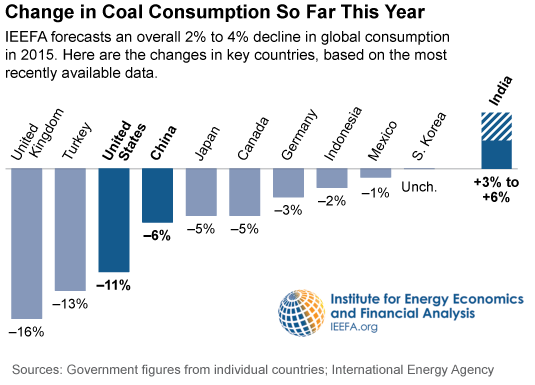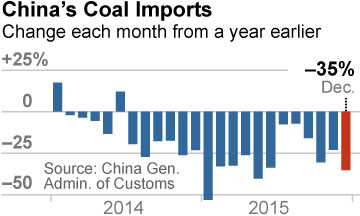Coal price hopes fade amid reality of slowing Asia demand: Russell
- Coal's bright start to the year in Asia is fading amid the gloom of weak demand across the region's top importers and still too much supply from top producers.
The benchmark Newcastle weekly coal index ended at $51.13 a ton on April 1, down from its high so far this year of $52.59, reached on March 11.
That peak capped a rally of 11 percent from the almost 10-year low of $47.37 a ton plumbed in the week to Jan. 21, but it now appears it was nothing more than a false dawn.
Coal was most likely the beneficiary of better sentiment towards commodities in general that saw strong rallies in iron ore and crude oil in recent weeks, which have also petered out.
in general that saw strong rallies in iron ore and crude oil in recent weeks, which have also petered out.
But while there may be some positive fundamentals in other commodities markets, with tentative signs of a recovery in China's vast manufacturing sector, there is no silver lining in sight for coal.

China's official Purchasing Managers' Index expanded for the first time in 9 months in March, rising to 50.2, up from February's 49 to be just over the 50-line that demarcates expansion from contraction in the manufacturing sector.
While this may herald better times ahead for sectors such as iron ore, steel, aluminum, copper and crude oil, the joy is unlikely to be shared by coal.
China aims to keep the rise in its total energy use to just 0.9 percent in 2016, the same rate as 2015, the National Energy Administration said on April 1.
as 2015, the National Energy Administration said on April 1.
For coal, the important part is that the plan also calls for coal's share of that total to be cut to 63 percent from last year's 64 percent.
If a cut of 1 percentage point doesn't sound that significant, its worth noting that China's total energy consumption is about 4.34 billion tonnes of coal equivalent, meaning 1 percentage point is about 43.4 million tonnes.
While the lower coal consumption is most likely to result in lower domestic output, if it was taken from imports, it would amount to roughly one-fifth of 2015's total imports of 204.06 million tonnes.

China plans to shut 60 million tonnes of domestic coal output this year, and 500 million tonnes in total over the next five years.
However, this isn't necessarily bullish for imports, as even cuts of this magnitude will still leave sufficient domestic coal to meet demand, leaving imports to compete on a price basis in specific markets, particularly those in China's industrial southeast.
In the first two months of this year, China's coal imports have dropped 10.2 percent, a slower rate of decline than the almost 30-percent decline experienced in 2015.
But a look at the details show major coal exporters Australia and Indonesia are struggling to ship the fuel to the world's top buyer.
Imports from Australia are down almost 18 percent in the first two months from the same period a year ago, while those from Indonesia have slumped 21.7 percent.
The surprise winner in China so far this year has been North Korea, which has boosted its shipments to its neighbor by 26.9 percent and is now just behind Indonesia as the third-biggest supplier.
As with anything to do with North Korea, there is possibly a political element in these purchases, but no matter the motivation the fact remains that China's main suppliers are being squeezed by a competitor they know very little about.
IMPORTS DOWN IN TOP BUYERS
Outside of China there is little reason for coal exporters to be optimistic, with imports by No.2 buyer India still trending lower despite a modest uptick in February.
India imported 16.79 million tonnes in February, up 1.7 percent from the same month a year ago and the first increase in eight months.
But given that state producer Coal India has recently had to scale back mining activity as consumption growth has been weaker than supply growth, it's likely that the trend toward lower imports will persist.
Japan's total coal imports rose 1.2 percent in February from a year earlier, but purchases by the third-ranked importer were down 1.9 percent for the first two months of the year.
South Korea, Asia's fourth-biggest coal importer, saw its overseas purchases drop 17.6 percent in February from a year earlier, and they are down 6.5 percent for the first two months of the year.
With purchases down in the first two months of the year in Asia's four-biggest importers, it's clear that there is no demand justification for a sustained price rally in coal prices.
But these are several years away from coming on line, meaning coal exporters have to deal with the current weak market while hoping for future growth in demand.
Indonesia remains the main adjuster of market balance, with output in the Southeast Asian nation expected to drop to about 350 million tonnes in 2016 from 391 million, according to the energy ministry.
The industry expects exports to fall to less than 300 million tonnes this year from 330-360 million tonnes last year, as mines remain under pressure from low prices.
Australia's coal shipments also appear to be easing, with Newcastle Port, the world's largest coal-export harbor, reporting 24.72 million tonnes of coal exported in the first two months of the year, a 5.7-percent drop from the same period in 2015.

The overall picture from the coal sector is one of weak demand from importers, and continuing supply adjustments from exporters.
While this rules out any price rally, it may allow for prices to stabilize assuming exporters continue to adjust supply to balance the market.
(Editing by Joseph Radford)



No comments:
Post a Comment